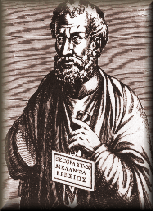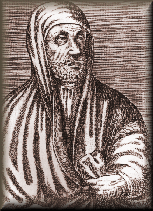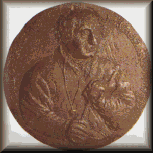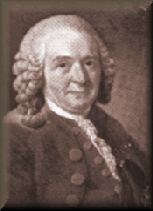Theophrastus: (c. 371- c.287 BC)

The first scientific botanist known to history was
the Greek philospher Theophrastus. Extending to plants a classification scheme that was developed by his
teacher Aristotle, Theophrastus wrote two works, Growth of Plants and Inquiry Into Plants,
which covered some 550 plants from Europe to India. These works were the first to classiffy plants by
form and structure, and prefigure the Linnaean system used today. Theophrastus was also a first-rate
observer: his description of germinating seeds, for example, was long unsurpassed. Yet he also transmitted
fantasies that were to haunt science for generations, such as the idea that plants were put on earth
solely for people's use, a notion implicit in the doctrine of signatures. As to his reason for mixing
myth with fact, Theophrastus wrote: "Fabulous tales are not made up without reason."
Mithridates:
(died 63 BC)
A special place in the history of medicinal plants
belongs to Mithridates VI, King of Pontus. Because he is said to have made himself immune to poisoning by
taking progressively larger doses of poison, his name lives on in the term mithridatism, 'acquired
tolerance of a poison.' Facing inevitable capture by Roman enemies, he reputedly tried in vain to poison
himself and had to get a slave to stab him to death. Accounts written after his death portray Mithridates
as a diligent biological investigator who knew 22 languages and studied medicine as well. An antidote
called the mithridate bore his name in mediaeval pharmacology. Mithridates' physician Crateus was also
well known during ancient times for his lifelike botanical paintings, now thought to have been the basis
for illustrations in Dioscorides' De Materia Medica.
Dioscorides:
(1st century AD)
The most influential pharmaceutical writer from
ancient times was the Greek physician Doiscrides, born near Tarsus (in modern Turkey) probably shortly
after the time of Christ. Little is known about Doiscrides' personal life, other than that he may have
served as a doctor with the Roman army. His pharmaceutical guide, De Materia Medica, deals with
more than 600 plants, 35 animal products and 90 minerals used in medicine. Illustrated manuscripts of the
De Materia Medica circulated during the next 1600 years throughout the West and Middle East.
One of its earliest print editions was published by that great Renaissance botanist-naturalist Pietro
Mattioli in Venice in 1533. The Mattioli edition is generally considered to be a cornerstone of modern
botany. A great many of the scientific and everyday plant name we use today can be traced back to
Dioscorides.
Pliny:
(23/23 - 79 AD)
"To live is to be awake" was the credo of the Roman
administrator and natural historian Pliny. His work, Natural History, written in 37 books, was a
major source both for botanists and herbalists from mediaeval times through to the seventeenth century.
Books 12 to 19 of the Natural History deal with botany, and books 20 to 27 with plant pharmacology.
Pliny and the Greek doctor Dioscorides, his contemporary, have been cited by writers on plants down to
the present century. Generations of authors passed along Pliny's words without attributing them to him -
so that many of his statements of fact and fancy have entered the folklore of plants. Pliny died in a
manner that was befitting a true naturalist: he went to investigate an eruption of Vesuvius, and on a
beach near Pompeii he succumbed to the volcanoe's sulphurous fumes. A vivd account of this scene exists
in a letter written by Pliny's nephew, who is called Pliny the Younger to distinguish him from his uncle,
who is sometimes known as Pliny the Elder.
Galen:
(130 - 200 AD)
The most famous physician of his day and a
prolific medical writer, Galen found his intellectual inspiration in Greek thought, particularly the
medicine of Hippocrates, the science of Aristotle and the philosophy of Plato. Born in Pergamum (now
Bergama, Turkey), Galen determined when he was only 16 years old to bring precision to the study of
medicine. He studied and travelled for the next 12 years, spending probably several years at Alexandria,
which was then the chief medical centre of the age. There Galen quickly outdistanced even the brightest
scholars with his intellectual ability. After returning to Pergamum and serving as a physician to the
gladiators there, Galen moved to Rome, about 161, where he established a large medical practice. He s
oon numbered influential Romans among his admiring patients and thus began his long association with
the rich and powerful, including Emperor Marcus Aurelius. Although Galen taught the now antiquated
concept of medicine as adjusting the body's humours, he also believed in the empirical method of testing
medicines, at that time a very modern stance. Not until the sixteenth and seventeenth centuries did
anyone challenge his medical authority. The terms 'galenic products' and 'galenicals' today refer to
medical substances extracted from plants by methods associated with Galen.
Avicenna:
(980 - 1037)
When he was barely out of his teens, the Persian
philosopher-statesman Avicenna earned a reputation as a healer by curing a ruler of a critical illness.
Thereafter he was in demand as a physician and adviser to princes. For the rest of his life he worked by
day as a minister of state and wrote by night on an encyclopaedic range of subjects, including medicine,
natural history, chemistry, physics, mathematics, astronomy, economics, political science, music and
theology. His poetry is quoted in the Arab world to this day. The most important of his works is the
voluminous Canon of Medicine, based on the writings of Hippocrates, Aristotle, Dioscorides,
Galen and others. To their writings Avicenna added his own theoretical and empirical observations.
Book 2 of the Canon of Medicine contains Avicenna's pharmacology of herbs. HE also discussed
various remedies such as chicory, oxymel and balsam. A Latin translation of the Canon of Medicine
existed within a century after Avicenna's death, and it was the basic medical text at all mediaeval
universities. The scientific revolution of the West was cruel to Avicenna. Leonardo da Vinci
(1352 - 1519) rejected his thoughts on anatomy. Paracelsus ( 1393 1531) destroyed a copy of the
Canon of Medicine while teaching medicine, and William Harvey (1578 -
1657), the physician who
discovered the circulation of the blood, demolished Avicenna's theories on this subject.
Hildegard of Bingen:
(1098 - 1179)

A mediaeval pioneer in natural science was the
German mystic Hidegard of Bingen, abbess of a Benedictine convent at Rupertsburg. A nun from the time
she was 15, Hildegard was taught the doctrine of the humours according to which the 'cardinal juice',
phlegm, caused most illness. She added her own broad knowledge of folk medicine, her interest in nature
and her developed powers of intuition. (Visions commanded her: "Write what you see and hear".)
Her writings include much on medicinal herbs. She is often called St Hildegard even though she was never
formally canonised by the Catholic Church.
Paracelus:
(1393 - 1531)

The prime mover of a new direction in medicine was
named at birth Theophrastus Bombastus von Hohenheim, bnut later took the name Philippus Aureolus
Paracelsus. The Swiss physician, who was also a chemist, realised that the medicinal virtues of plants
came from their chemical properties. He carried out pioneering work in the extraction of plant essences
and use of tinctures, a revolutionary advance in pharmacology, which durung Paracelsus' time settled for
less meticulous ways of producing drugs. Paracelsus was educated in botany, mineralogy, natural
philosophy and the occult, and he travelled widely, ministering to the poor wherever he went. He was
fired from his position at the University of Basel for disrespect for the establishment. His published
research in pharmacology and his unfinished herbal, On the Virtues of Plants, Roots and Seeds,
reveal his extensive work with botanical medicine both in the laboratory and in his practice.
The doctrine of signatures in plants - that in the appearance of plants can be found a divine sign of
their curative powers - appears often in his works and in the writings of his influential followers.
The doctrine left and enduring imprint on herbal medicine.
Pietro Mattioli:
(1501 - 1577)
A typical Renaissance man, Pietro Mattioli, the
Italian physician-naturalist, wrote several works in poetry and prose on a wide range of subject,
including botany and phamacology. After studying as a youth in Padua and Rome, he began a lifetime
career as a physician, first to the cardinal of Trent and then, later in his life, to the court of the
Holy Roman Emperor in Prague. All during these years, he devoted a great deal of time to the study of
plants and their 'materia medica', or medicinal substances. The publication that made Mattioli
famous was his Italian edition of Dioscorides' De Materia Medica. Its purpose wsa to give
Italian physicians and pharmacists systematically organised information that would enable them to
identify all the medicinal plants discussed in the Greek physician's herbal, then a highly trusted
source. The book was a best-seller from its first printing, in 1533. A decade later, Mattioli issued
an expanded edition in Latin. It included the plant names and their synonyms in a number of languages, a
expanded commentary and detailed illustrations. Conceived as a praactical reference tool, the book was
so successful that it went into an uniterrupted series of reprints over the next 200 years. Mattioli
continues to publish books on related subjects, including one on identifying and collecting medicinal
plants.
Nicholas Culpeper:
(1616 - 1653)
When in 1639 the English physician and botanist
Nicholas Culpeper published A Physical Directory (renamed in 1653 The London Dispensatory),
the medical establishment, in the royalist periodical Mercurius Pragmaticus, wrote of his work:
"He is arrived at the battlement of an absolute atheist and by two years' drunken labour hath gallimaufred
the apothecaries' book into nonsense, mixing every receipt (recipe) therein with rebellion or atheism,
besides the danger of poisoning men's bodies." Culpeper's great mistake was to have translated the Latin
Pharmacopoeia into everyday language, thus threatening the near monopoly on medical knowledge that
the College of Physicians enjoyed.
A clergyman's son, Culpeper attended Cambridge Univeristy and was well versed in Latin
and Greek, and both classical and contemporary medical authors. About 1630 he set up as an
apothecary-astrologer-healer in Spitalfields, near London. He fouhgt against the royalists in the English
Civil War, suffering a chest wound that may have hastened his early death from consumption. Besides A
Physical Directory, Culpeper published The English Physician Enlarged, in 1653, which contained
some 370 medicines made of English plants. He wrote numerous other works, all of which were well received by the general public but angered the medical establishment.
Carolus Linnaeus:
(1707 - 1778)

No less an ambition than to name and to categorise
everything in the 'three kingdoms' of nature - plants, animals and minerals - inspired young Carolus
Linnaeus (or Carl von Linne), son of a Lutheran clergymen. Aiming so high, this great Swedish scientist
fell short, but he put his stamp on all future study of botany. Linnaeus' pre-eminence in the
intellectually rigorous field of botanical taxonomy (plant classification) has tended to obscure
countryside on collecting expeditions - such as the one Lapland in 1732, from which he produced
Flora Laponica in 1737. Nor is it generally remembered the Linnaeus received his doctorate in
medicine in Holland and was an assistant to the botany instructor at the University of Uppsala (Sweden),
where he lectured on various subjects, such as how to cope with the pressures of modern life and the
basic rules of hygiene. He also practised medicine in Stockholm.
Even though Linnaeus' criteria for classifying plants have undergone revision,
binomial nomenclature, the system of two-part names - genus and species - he devised, has continued to
serve science well. His preoccupation with taxonomy, however, probably set back other aspects of
botanical study, such as plant physiology. Linneaus' fame was assured as much by his students, who
travelled the world collecting plants on his behalf, as by his written works such as Systema Naturae (1735), and Philosophia Botanica (1751). His tomb carries the epitaph "The Prince of Botanists".
Sammuel Hahnemann:
(1755 - 1833)
A towering figure in herbal tradition is that of
the German chemist-physician Samuel Hahnemann, founder of an alternative system of medicine known as
Homoeopathy. After ten year's practice as a physician, he retired from conventional medicine because
he was disillusioned with excessive procedures - such as blood-letting, debilitating purges and dangerous
drugs - that were routinely prescribed by medical practitioners at that time.
In the 1790's, after six years of research, Hahnemann discovered that Peruvian bark
(also known as cinchona, the source of quinine) was effective in treating malaria, and from his discovery
deduced the basic principle of homoeopathy, that is: "Like cures like".
What this meant, in practice, was that an infinitesimal dose of a drug that was
capable of producing in a healthy person a response similar to a disease's primary symptom, could also
produce a reaction that would overcome the disease in a sick person's body. This and related tenets
were set forth in Hahnemann's Organum of Medicine, published in 1810, and form the conceptual
basis of homoeopathy. An empirical basis was provided by Hahnemann's monumental Materia Medica
Pura, comprising detailed summaries of 'provings' (proofs of effectiveness) for many, mainly plant,
substances.
Hahnemann's homoeopathic ideas were not well received by the medical establishment.
After the apothecaries refused to dispense the miniscule amounts of drugs prescribed by Hahnemann, he
gave his medicines illegally and was consequently prosecuted. He rejected the medical practices and
pharmaceutical industry of his day. His application of plant tinctures and his counsels of moderation
in diet and the ingestion of coffee, tea, alcohol and tobacco are to be commended and presage views
that are heard now in the twenty-first century.